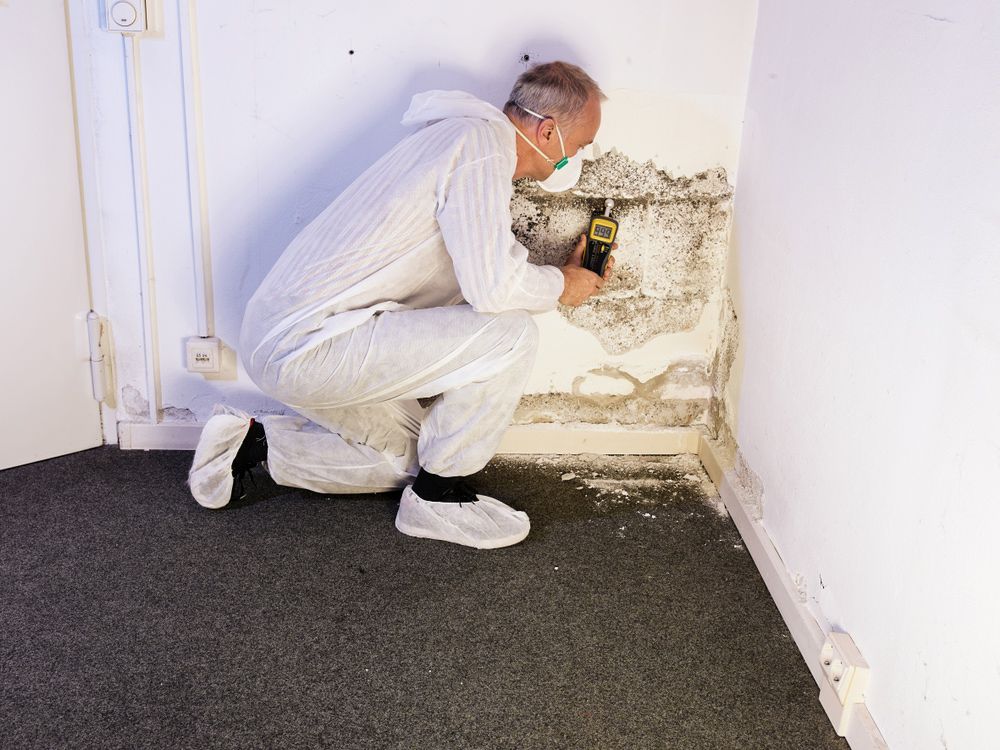Why We Test
Problems in Home & Building Environments
Over the past few years, mold has become the environmental buzzword with air quality problems in home and building environments. Mold follows a litany of other home pollutants that have caused extensive attention: asbestos, lead, radon, etc… We at Envirotest do not want to downplay mold as a problem in building environments, however, we feel that education is the best way to dispel any inaccurate, exaggerated and in many cases simply untrue focus directed just to mold as the culprit for air quality problems.
The indoor environment is a creation of the modern era. Previously, buildings were notable for the extent to which they were open to the outside air, know as "Natural ventilation." But, technological advances have permitted us to seal buildings tightly, recirculate the air within them, and fill them with a variety of particle and chemical-emitting materials and objects.
Sick Building
Sick Building Syndrome/Symptoms are associated illnesses which are directly related to indoor environments. The symptoms are various and related to the many different items and factors that make up the the indoor environment. Investigation starts with revealing a pattern of complaints that span multiple individuals. The chief clues to the building as the cause are:
(a) the presence of symptoms while working or living in the building.
(b) symptoms clearing upon leaving the building and living/working elsewhere for a while.
(c) the return of the symptoms upon return to the building.
(d) the presence of the symptoms in multiple individuals. Typically, there will be be a few individuals who are severely affected, a larger number with moderate symptoms, and then others with no symptoms.
What Factors Seem to Most Often Cause the Sick Building Syndrome?
Building Factors
* Mechanical ventilation
* Relative humidity
* Fresh air ventilation rates
Specific Environmental Factors & Pollutants
* Volatile organic compounds (VOCs): formaldehyde, solvents, etc.
* Carbon monoxide: Stoves, heaters, and furnaces
* Dust & fibres: asbestosis, fibreglass, dirt
* Bioaerosols: Bacteria, molds, viruses, pollen, dust mites, animal danders, animal excreta
* Trapped outdoor pollutants: vehicle or industrial exhausts
* Physical factors: Lighting, vibration, noise, temperature, crowding, photoduplication
Personal Factors
* Hypersensitive Senses (chemically sensitive individuals)
* History of being allergic (atopic)
* Job-related tensions
* Job dissatisfaction
Specific Illnesses
* Allergic reactions to indoor allergens such as dust mites, plant products, or fungal products.
* Irritation due to (volatile/non-volatile) chemicals released from the environment.
* Carbon monoxide poisoning related to recirculation of cigarette smoke or exhaust fumes.
Non-Specific Illnesses
* This is a diverse group of work-related symptoms that include irritation of the skin, mucous membanes (mouth, nose, throat), headache, fatigue, and difficulty concentrating.
* A variety of factors have been associated with increased rates of these complaints: younger age, female, cigarette smoking, type of work (e.g., working near a photocopier), level of office crowding, presence of carpets, and type/volume of ventilation.
Searching for Molds
A visual and olfactory (look and smell) inspection is the most important step in identifying a possible contamination problem. You are done with cleanup when:
(a) there is no visible mold.
(b) there are no mold odors.
(c) you have fixed the moisture/water problem so that it will not recur.
If sampling of surfaces needs to be done, there are several possible strategies:
1. Air sampling utilizing culture tests and microscopic analysis.
2. Tape Lift Sampling to inspect whatever sticks to the tape for the presence of fungal fragments.
3. Swabbing the surface and culture the collected material.
4. Vacuuming the surface and then inspect the contents of the vacuum cleaner bag.
5. Bulk sampling of surface or material and either culture it or inspect it microscopically.
There are no widely accepted standards for what represents a good or bad level of fungus in the environment.
None of the publications from the CDC or EPA support any specific cut-off or threshold value. For example, the EPA website as of September 2005 states that "Standards or Threshold Limit Values (TLVs) for airborne concentrations of mold, or mold spores, have not been set. Currently, there are no EPA regulations or standards for airborne mold contaminants."
Envirotest's mold testing professionals cover issues in buildings that range from industrial settings to residential homes where human health may be an issue. The major issues asked of Envirotest when on an inspection are as follows:
* How do you detect and measure the presence of mold?
* What is an acceptable level of indoor fungi?
* How do we relate this information to human health problems?
* How do we control the level of fungi in our environment?
Molds are simply everywhere, and random sampling will almost always turn up at least a few colonies of molds. Thus, before sampling you always want to think about what you'll do with the results. You must always keep in mind that we do not live in sterile conditions, molds that aren't visible and that aren't growing are usually not a problem!
Fungi Problems in Building Environments
First, building structural damage may follow from mold growth on (or in) walls, ceilings, floors and other areas in the home. When molds have grown on walls, they may have also grown through the wallboard into the internal wall cavity. Mold growth on items inside a room such as carpets, furniture, etc..can concurrently occur. The molds associated with indoor environment problems grow on damp to wet materials containing cellulose and other sources of nutrients.
Secondly, concern regarding indoor molds, is their potential to cause human disease. Infection is unlikely unless the exposed person has a very reduced functioning of the immune system (e.g., is on long-term therapy with high doses of corticosteroids). The diseases caused by indoor fungi can be either allergic, toxic, or a combination of both.
Environmental Mold Testing
Envirotest Follows the Procedure
Envirotest walks the establishment with either the owner or a person familiar with the establishment. During this inspection, Envirotest visually assess the walls and ceilings areas of the building. Inspection checks for obvious structural support disturbances and cracks at connection lines between additions are noted. Envirotest carefully observes for disturbances between any discoloration and olfactory indications (mold smells).
Next Envirotest brings in the “tools”:
1. The Thermal Imager identifies micro-temperature differences in building materials and can easily identify hidden problems deep within walls
2. Moisture detecting equipment is then used to sense for moisture on the surface and deep within wall cavities.
3. Ultra-fine Airborne Particle sensing equipment to detect differences in airborne particles in different parts of the home.
4. Macro-Particulate sampling equipment to detect large suspended airborne particulate in the home.
5. Volatile Organic Compounds testing for micro-odor identification and localization.
6. Boroscopic Examination where we visually inspect the interior of wall cavities to determine the presence of mold colonies and or water marks inside building materials.
7. Roof ventilation checks are performed.
8. Exterior Investigation is then performed utilizing the thermal imager and any other tools deemed necessary by the inspector.
Envirotest then performs the general air quality assessment which includes the following:
1. Carbon Monoxide (CO) in non-industrial facilities is found at 1.2 to 4.2 ppm (parts per million). The National Ambient Air Quality Standard for outside air is 9 ppm for an 8 hour exposure and 35 ppm for a one-hour exposure.
2. Carbon Dioxide is a general indicator of IAQ Levels greater than 900 ppm are often accompanied by complaints about air quality. Carbon dioxide itself is not the problem, but is rather a marker of other pollutants that accumulate along with it.
3. Temperate and Relative Humidity should be ~70-75F and 30-50%.
4. Testing for Ozone, Nitrogen Oxides, NH3 (Ammonia), Hydrogen Sulfides, Chlorine, and others as necessary to determine if the mechanical systems in the establishment are functioning properly or if the property is drawing pollutants from the outside.
5. If other Air quality or Environmental testing tools are neccesary to identify problems with the indoor environment, Envirotest will most likely have them onsite or will advise the customer to set up a follow-up test.
If mold sampling of surfaces needs to be done, there are several possible strategies:
1. If we see a stain that might be mold, we place a piece of transparent tape on the stain, pull the tape off, bring it back to the lab and inspect whatever sticks to the tape for the presence of fungal fragments.
2. We can swab the surface and culture the collected material.
3. We can vacuum the surface and then inspect the contents of the vacuum sample.
4. We can cut out a piece of the surface or material and either culture it or inspect it microscopically.
Searching for Mold in The Air
- Particle counts
- Particle analysis
- Air cultures
Remediation Plan
Once control has been established over moisture/vapor, a cleanup plan can then be enacted (abatement plan). Small areas of infestation can often be cleaned up with simple tools, and we offer a step-by-step approach below. Larger areas, however, should usually be tackled by a professional cleanup firm. The more extensive the contamination, the greater the personal risk of exposure during the cleanup process. Extensive containment procedures may be required to prevent damage to other parts of the building. The EPA document entitled Mold Remediation in Schools and Commercial Buildings gives a great deal of insight into the potential level of complexity of a large cleanup process.
Your remediation plan will also include a monitoring plan which will discuss moisture, humidity and vapor reduction. Generally, one needs to reduce the moisture content of porous materials such as wallboard to < 15%, and this can be monitored with a variety of hand-held moisture meters. Controlling humidity in the indoor environment is then discussed. The target here is 30-45% relative humidity and again, a variety of hand-held meters are utilized. Don't rely on just one set of readings! Things change with seasons and operation of the heating vs. the cooling aspects of the HVAC system. If you had moisture problems once, they may recur. Systematic surveillance may be needed!



